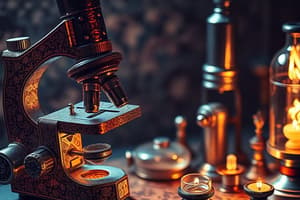Podcast
Questions and Answers
Which part of the microscope is primarily responsible for magnifying the specimen?
Which part of the microscope is primarily responsible for magnifying the specimen?
- Base
- Ocular lens (correct)
- Stage
- Iris diaphragm
Which of the following microscopes would be best suited for viewing live cells in their natural state?
Which of the following microscopes would be best suited for viewing live cells in their natural state?
- Electron microscope
- Phase-contrast microscope (correct)
- Dark field microscope
- Confocal microscope
What characteristic distinguishes spirogyra from amoeba?
What characteristic distinguishes spirogyra from amoeba?
- Both are photosynthetic organisms.
- Spirogyra has a filamentous structure and chloroplasts, whereas amoeba is shapeshifting. (correct)
- Spirogyra is unicellular while amoeba is multicellular.
- Amoeba reproduces only asexually.
What is a key function of the base of the microscope?
What is a key function of the base of the microscope?
Which statement is true regarding rizopus?
Which statement is true regarding rizopus?
Flashcards are hidden until you start studying
Study Notes
Parts and Functions of the Microscope
- Eyepiece (Ocular lens): Magnifies the image for viewing.
- Objective lenses: Multiple lenses with varying magnifications (e.g., 4x, 10x, 40x, 100x).
- Stage: Platform holding the specimen slide, often adjustable.
- Illuminator (Light source): Provides illumination for better visibility.
- Diaphragm: Controls the amount of light reaching the specimen.
- Focusing knobs (Coarse and Fine): Adjust clarity of the image.
- Base and Arm: Structural support for stability and ease of handling.
Different Types of Microscopes
- Light Microscope: Uses visible light; suitable for observing live specimens.
- Compound Microscope: Multiple lenses; high magnification for detailed images.
- Electron Microscope: Uses electrons for much higher resolution; ideal for ultrastructural studies.
- ** Fluorescence Microscope**: Uses fluorescence to visualize samples; effective for studying specific cellular components.
- Confocal Microscope: Provides 3D imaging using a laser; enhances contrast and clarity.
Uses of Microscopes
- Biological Research: Studying cellular structures and types.
- Medical Diagnostics: Examining samples for diseases (e.g., blood, tissues).
- Material Science: Analyzing the composition and properties of materials.
- Education: Teaching and demonstrating cellular biology concepts.
Calculations in Microscopy
- Magnification Calculation: Total magnification = eyepiece magnification x objective lens magnification.
- Field of View Estimation: Using the diameter of the lens; decreases as magnification increases.
Parts and Functions of Algae
- Chloroplasts: Site of photosynthesis, containing chlorophyll pigments.
- Cell Wall: Provides structure and protection; made of cellulose.
- Pyrenoid: Organelle that synthesizes starch.
- Flagella: Whip-like structures for locomotion in some algal types.
Spirogyra Characteristics
- Filamentous structure: Composed of long threads or filaments.
- Chloroplast arrangement: Spiral or ribbon-like inside cells.
- Reproduction: Asexual through fragmentation; sexual via conjugation.
Rhizopus Characteristics
- Fungal type: Common bread mold; belongs to Zygomycetes.
- Hyphal structure: Made up of multinucleate cells; rapid growth.
- Reproduction: Asexual via sporangiospores; sexual through zygospores.
Amoeba Characteristics
- Single-celled organism: Part of the protozoa group, exhibits irregular shape.
- Locomotion: Uses pseudopodia (false feet) for movement and feeding.
- Nutrition: Heterotrophic; engulfs food via phagocytosis.
Calculations for Algae, Spirogyra, Rhizopus, and Amoeba
- Grid Counting: Estimating cell concentration using a hemocytometer.
- Biomass Measurement: Dry weight method or chlorophyll content for algae studies.
Differences Between Algae, Spirogyra, Rhizopus, and Amoeba
- Cellular Structure: Algae and Spirogyra are photosynthetic, whereas Rhizopus is fungal and Amoeba is protozoan.
- Reproductive Methods: Spirogyra reproduces through conjugation, Rhizopus through spores, and Amoeba by binary fission.
- Locomotion: Amoeba moves using pseudopodia; algae and Rhizopus are typically stationary.
- Habitat: Algae are aquatic, Rhizopus often found on decaying matter, and Amoeba in various moist environments.
Studying That Suits You
Use AI to generate personalized quizzes and flashcards to suit your learning preferences.




